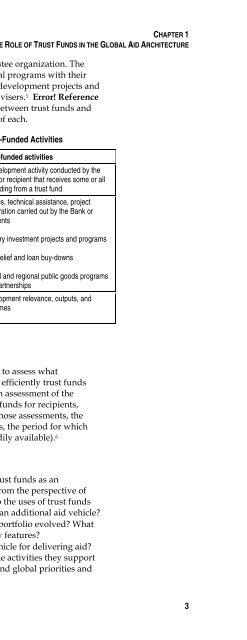An Evaluation of the World Bank's Trust Fund Portfolio
An Evaluation of the World Bank's Trust Fund Portfolio
An Evaluation of the World Bank's Trust Fund Portfolio
- No tags were found...
Create successful ePaper yourself
Turn your PDF publications into a flip-book with our unique Google optimized e-Paper software.
CHAPTER 3THE RELEVANCE AND EFFECTIVENESS OF TRUST FUND SUPPORT FOR DEVELOPMENT3.26 Investing in global public goods at <strong>the</strong> country level. Grantfinancing provided by trust funds has been instrumental inpromoting investments in developing countries for <strong>the</strong> provision <strong>of</strong>global or regional public goods. Most <strong>of</strong> this investment to date hasfocused on control <strong>of</strong> communicable diseases; environmentalpreservation; and, more recently, climate change adaptation andmitigation. On issues involving global externalities, “grants are anincentive to trigger internal actions within countries and also provide<strong>the</strong> Bank with a way to engage with line ministries in middle-incomecountries,” according to a Bank sector manager.Box 3.7 Bank-Managed Carbon <strong>Fund</strong>s: Innovative But Limited Catalytic ImpactThe Carbon <strong>Fund</strong>s are used to support emissions-reductions purchaseagreements—or transactions—that provide financing for low-carbonprojects. These funds, and <strong>the</strong> Carbon Finance Unit in <strong>the</strong> Bank, wereestablished as pilots for testing <strong>the</strong> concept <strong>of</strong> a carbon market and <strong>the</strong> novelchallenge <strong>of</strong> defining, creating, and trading carbon as a commodity as wellas integrating this challenge with development goals.As an institutional innovation <strong>the</strong> funds have played an importantdemonstration role in helping to open a new mode <strong>of</strong> environmentalfinancing, popularizing <strong>the</strong> idea <strong>of</strong> carbon markets, and contributing to <strong>the</strong>institutional infrastructure <strong>of</strong> <strong>the</strong> market. The role <strong>of</strong> <strong>the</strong> Bank in thisbusiness was established with an exit strategy that called for it to relinquishits role as a carbon <strong>of</strong>fset buyer as <strong>the</strong> private market began to flourish. Yet,while <strong>the</strong> Bank has moved into higher-risk, pilot areas over time, itcontinues to build up its lower-risk business after <strong>the</strong> market has taken <strong>of</strong>f.As a vehicle for catalytic finance and technology transfer, <strong>the</strong> record <strong>of</strong> <strong>the</strong>Carbon <strong>Fund</strong>s is mixed. The emission reduction purchases are supposed tostimulate green investments that would not o<strong>the</strong>rwise happen. In practice,<strong>the</strong>y have contributed to <strong>the</strong> diffusion <strong>of</strong> a number <strong>of</strong> technologies andsupported innovative technology investments in some countries. But much<strong>of</strong> <strong>the</strong> support for energy technologies has gone to projects where <strong>the</strong>Carbon <strong>Fund</strong> financial leverage—and hence its catalytic impact—has beenrelatively small.Source: IEG (2010a).3.27 Four examples illustrate <strong>the</strong> range <strong>of</strong> issues and activitiessupported by <strong>the</strong>se global public goods trust funds. The Global <strong>Fund</strong>(discussed earlier) and <strong>the</strong> GAVI <strong>Fund</strong> Financial Intermediary bothaddress problems <strong>of</strong> communicable diseases and provide financing thathas its greatest benefits at <strong>the</strong> country level. The Ozone Phase Out trustfund was established to help countries meet <strong>the</strong>ir commitments under<strong>the</strong> Montreal Protocol. <strong>An</strong> IEG evaluation found that it workedreasonably well because <strong>of</strong> its laser-like focus on its core objective,funding <strong>of</strong> programs for which <strong>the</strong>re was strong country ownership, andcapacity building support, notably as a key component <strong>of</strong> Bank-By <strong>of</strong>feringgrant financingand supportingcustomizedgovernancearrangements,trust funds havebeeninstrumental infosteringcountry-levelinvestments in<strong>the</strong> provision <strong>of</strong>global andregional publicgoods.35
















